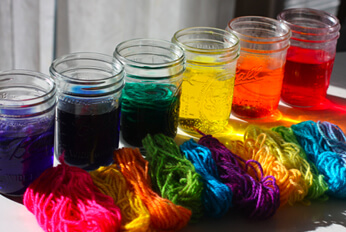Textile chemical dyes are known to have superior fastness properties due to the molecular bonding that occurs during the dyeing process. Textile chemical dyes are commonly used in dyeing of cellulose like cotton, wool and nylon. Textile dyeing is a well-accepted method for the coloration of cellulose fibre as it attaches itself to their substrates by a chemical reaction to form a covalent bond between the molecules of the dye and the fibre.
The dyestuff or color thus becomes a part of the fibre and
reduces the likelihood of its removal or fading during washing, when compared
to dyeing by adsorption method. This formation of covalent bonds with the
substrate to be coloured is one of the most important characteristic of
Reactive Dyes.
To get specifications for a specific Reactive Dye
manufactured by Jay Chemicals, select your dye/printing process in the table
below, click a product from the applicable range of Reactive Dyes to get
specifications and downloadable brochure for the your specific requirement.
Recommended colouration process details are also provided, to provide you all
the information required to satisfy your requirements.
Application of Textile Chemical Dyes
Our textile chemical dyes can be used through different
processes. Take a look at some of them.
1. Exhaust Dyeing:
This is also called discontinuous systems, in which the dye
is dispersed in a liquor. You can immerse Cosmonaut’s reactive dyes for cotton
in a liquid and then add the fabric into it. The fabric must be removed when
the dye is fully dissolved on the material. The last step is to wash and rinse
the fabric, so that the dye, which hasn’t fixed on the fabric will be removed.
2. Pad Dyeing:
This is a semi or fully continuous process of dyeing of
cotton with textile dyes. You can use this pad batch wetting system, which is a
mechanical process. A homogenous process of distribution is used for spreading
the dye. The dye gets submerged in the fabric in its second stage, and later it
is washed.
3. Exhaust Dyeing:
Cosmonaut’s fiber reactive dyes can be used for cotton,
staple fibers, yarns, and other fabrics. The process of exhaust dyeing will
allow you to create a dye liquid and then let the material get dyed only on the
surface. Its results rely on the turbulence of the liquid. Once the dye is
connected with the fiber, it starts getting submerged or get fixed on the
fiber. This stage needs to check on the temperature as well. Once fixed, you
can have rightly distributed dyeing on the fabric.
Get the best textile chemical dyes with Sudeep Industries at the best pricing and quality.

No comments:
Post a Comment